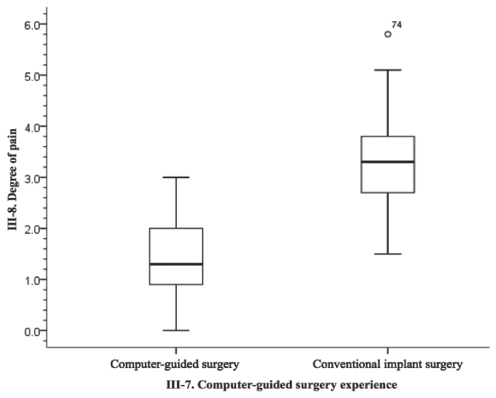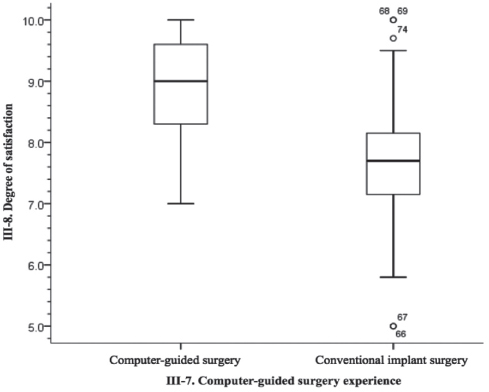J Adv Prosthodont.
2014 Oct;6(5):395-405. 10.4047/jap.2014.6.5.395.
A survey of the satisfaction of patients who have undergone implant surgery with and without employing a computer-guided implant surgical template
- Affiliations
-
- 1Department of Prosthodontics, Ewha Womans University, Seoul, Republic of Korea. jimarn@ewha.ac.kr
- 2Department of Oral and Maxillofacial Surgery, Asan Medical Center, Seoul, Republic of Korea.
- 3Department of Prosthodontics & Dental Research Institute, Seoul National University, Seoul, Republic of Korea.
- 4Department of Prosthodontics, S-PLANT Dental Hospital, Seoul, Republic of Korea.
- 5Department of Medical Statistics, Catholic University of Daegu School of Medicine, Daegu, Republic of Korea.
- KMID: 2284740
- DOI: http://doi.org/10.4047/jap.2014.6.5.395
Abstract
- PURPOSE
This study aims to investigate the degree of subjective pain and the satisfaction of patients who have undergone an implant treatment using a computer-guided template.
MATERIALS AND METHODS
A survey was conducted for 135 patients who have undergone implant surgery with and without the use of the computer-guided template during the period of 2012 and 2013 in university hospitals, dental hospitals and dental clinics that practiced implant surgery using the computer-guided template. Likert scale and VAS score were used in the survey questions, and the independent t-test and One-Way ANOVA were performed (alpha=.05).
RESULTS
The route that the subjects were introduced to the computer-guided implant surgery using a surgical template was mostly advices by dentists, and the most common reason for which they chose to undergo such surgery was that it was accurate and safe. Most of them gave an answer that they were willing to recommend it to others. The patients who have undergone the computer-guided implant surgery felt less pain during the operation and showed higher satisfaction than those who have undergone conventional implant surgery. Among the patients who have undergone computer-guided implant surgery, those who also had prior experience of surgery without a computer-guided template expressed higher satisfaction with the former (P<.05).
CONCLUSION
In this study, it could be seen that the patients who have undergone computer-guided implant surgery employing a surgical template felt less pain and had higher satisfaction than those with the conventional one, and the dentist's description could provide the confidence about the safety of surgery.
MeSH Terms
Figure
Cited by 2 articles
-
Accuracy of a direct drill-guiding system with minimal tolerance of surgical instruments used for implant surgery: a prospective clinical study
Du-Hyeong Lee, Seo-Young An, Min-Ho Hong, Kyoung-Bae Jeon, Kyu-Bok Lee
J Adv Prosthodont. 2016;8(3):207-213. doi: 10.4047/jap.2016.8.3.207.A case report of a surgical guide fabricated via intraoral scanning-based implant planning and wax-based rapid prototyping
Jong-Hoon Shin, Eun-Jin Park, Ji-Man Park
J Korean Acad Prosthodont. 2015;53(3):244-249. doi: 10.4047/jkap.2015.53.3.244.
Reference
-
1. Hong SJ, Paik JW, Kim CS, Choi SH, Lee KW, Chai JK, Kim CK, Cho KS. The Study of Implant Patient's Type and Implant Distribution. J Korean Acad Periodontol. 2002; 32:539–554.2. Baek JW. Dental Implant. Korean Soc Eng Educ. 2002; 1:87–90.3. Brånemark PI, Hansson BO, Adell R, Breine U, Lindström J, Hallén O, Ohman A. Osseointegrated implants in the treatment of the edentulous jaw. Experience from a 10-year period. Scand J Plast Reconstr Surg Suppl. 1977; 16:1–132.4. Rahman AU, Rehman TU, Qureshi I, Hashim M, Warris N, Mateen S. Pre surgical perception of pain, post surgical pain and its management for patients undergoing dental implant therapy. J Pak Dent Assoc. 2012; 21:5–11.5. Jaffin RA, Kumar A, Berman CL. Immediate loading of implants in partially and fully edentulous jaws: a series of 27 case reports. J Periodontol. 2000; 71:833–838.6. Canullo L, Fedele GR, Iannello G, Jepsen S. Platform switching and marginal bone-level alterations: the results of a randomized-controlled trial. Clin Oral Implants Res. 2010; 21:115–121.7. Cannizzaro G, Leone M, Consolo U, Ferri V, Esposito M. Immediate functional loading of implants placed with flapless surgery versus conventional implants in partially edentulous patients: a 3-year randomized controlled clinical trial. Int J Oral Maxillofac Implants. 2008; 23:867–875.8. Van der Zee E, Oosterveld P, Van Waas MA. Effect of GBR and fixture installation on gingiva and bone levels at adjacent teeth. Clin Oral Implants Res. 2004; 15:62–65.9. Brodala N. Flapless surgery and its effect on dental implant outcomes. Int J Oral Maxillofac Implants. 2009; 24:118–125.10. Jeong SM, Choi BH, Kim J, Xuan F, Lee DH, Mo DY, Lee CU. A 1-year prospective clinical study of soft tissue conditions and marginal bone changes around dental implants after flapless implant surgery. Oral Surg Oral Med Oral Pathol Oral Radiol Endod. 2011; 111:41–46.11. Becker W, Wikesjö UM, Sennerby L, Qahash M, Hujoel P, Goldstein M, Turkyilmaz I. Histologic evaluation of implants following flapless and flapped surgery: a study in canines. J Periodontol. 2006; 77:1717–1722.12. Azari A, Nikzad S. Flapless implant surgery: review of the literature and report of 2 cases with computer-guided surgical approach. J Oral Maxillofac Surg. 2008; 66:1015–1021.13. Sudbrink SD. Computer-guided implant placement with immediate provisionalization: a case report. J Oral Maxillofac Surg. 2005; 63:771–774.14. Lee JH, Park JM, Kim SM, Kim MJ, Lee JH, Kim MJ. An assessment of template-guided implant surgery in terms of accuracy and related factors. J Adv Prosthodont. 2013; 5:440–447.15. Park JM, Yi TK, Jung JK, Kim Y, Park EJ, Han CH, Koak JY, Kim SK, Heo SJ. Accuracy of 5-axis precision milling for guided surgical template. J Korean Acad Prosthodont. 2010; 48:294–300.16. Valente F, Schiroli G, Sbrenna A. Accuracy of computer-aided oral implant surgery: a clinical and radiographic study. Int J Oral Maxillofac Implants. 2009; 24:234–242.17. Fortin T, Bosson JL, Coudert JL, Isidori M. Reliability of preoperative planning of an image-guided system for oral implant placement based on 3-dimensional images: an in vivo study. Int J Oral Maxillofac Implants. 2003; 18:886–893.18. Misir AF, Sumer M, Yenisey M, Ergioglu E. Effect of surgical drill guide on heat generated from implant drilling. J Oral Maxillofac Surg. 2009; 67:2663–2668.19. Marković A, Mišić T, Miličić B, Calvo-Guirado JL, Aleksić Z, ÐDinić A. Heat generation during implant placement in low-density bone: effect of surgical technique, insertion torque and implant macro design. Clin Oral Implants Res. 2013; 24:798–805.20. Jeong SM, Yoo JH, Fang Y, Choi BH, Son JS, Oh JH. The effect of guided flapless implant procedure on heat generation from implant drilling. J Craniomaxillofac Surg. 2013; S1010-5182(13).21. Kim KW, Lee KS, Kang PS, Kim WS, Lee HK. Comparison of chewing ability and quality of life before and after the dental implantation. J Korean Acad Prosthodont. 2009; 47:215–221.22. Attard NJ, Zarb GA. Implant prosthodontic management of partially edentulous patients missing posterior teeth: the Toronto experience. J Prosthet Dent. 2003; 89:352–359.23. Zarb GA, Albrektsson T. Consensus report: towards optimized treatment outcomes for dental implants. J Prosthet Dent. 1998; 80:641.24. McGrath C, Lam O, Lang N. An evidence-based review of patient-reported outcome measures in dental implant research among dentate subjects. J Clin Periodontol. 2012; 39:193–201.25. Erkapers M, Ekstrand K, Baer RA, Toljanic JA, Thor A. Patient satisfaction following dental implant treatment with immediate loading in the edentulous atrophic maxilla. Int J Oral Maxillofac Implants. 2011; 26:356–364.26. González-Lemonnier S, Bovaira-Forner M, Peñarrocha-Diago M, Peñarrocha-Oltra D. Relationship between preoperative anxiety and postoperative satisfaction in dental implant surgery with intravenous conscious sedation. Med Oral Patol Oral Cir Bucal. 2010; 15:e379–e382.27. Han JH, Kim KE. Comparison of Expectation and Satisfaction of Implant Patients in Pre-post Implant Therapy. J Dent Hyg Sci. 2011; 11:121–127.28. Heo YY, Heo SJ, Chang MW, Park JM. The patients' satisfaction following implant treatment. J Korean Acad Prosthodont. 2008; 46:569–576.29. Choi BH, Jeong SM, Kim J, Engelke W. Flapless implantology. 1st ed. London: Quintessence Publishing Co;2010. p. 66–71.30. Van Assche N, van Steenberghe D, Guerrero ME, Hirsch E, Schutyser F, Quirynen M, Jacobs R. Accuracy of implant placement based on pre-surgical planning of three-dimensional cone-beam images: a pilot study. J Clin Periodontol. 2007; 34:816–821.31. Horwitz J, Zuabi O, Machtei EE. Accuracy of a computerized tomography-guided template-assisted implant placement system: an in vitro study. Clin Oral Implants Res. 2009; 20:1156–1162.32. Huskisson EC. Measurement of pain. Lancet. 1974; 2:1127–1131.33. Meskin LH, Brown LJ. Prevalence and patterns of tooth loss in U.S. employed adult and senior populations, 1985-86. J Dent Educ. 1988; 52:686–691.34. Kim GU, Cho SM. A Study on the Factors Giving Effects to Patient's Satisfaction in the Selection of Implant Operation. J Korea Acad-Ind Coop Soc. 2010; 11:4354–4359.35. Shin HC, Choi HS. The Impact of Physician Behaviors on Patient Satisfaction. J Korean Acad Fam Med. 1994; 15:1157–1170.36. Kvale G, Berg E, Nilsen CM, Raadal M, Nielsen GH, Johnsen TB, Wormnes B. Validation of the Dental Fear Scale and the Dental Belief Survey in a Norwegian sample. Community Dent Oral Epidemiol. 1997; 25:160–164.37. Han SH. Anxiety and fear of dental patient. J Korean Dent Assoc. 1993; 31:1–8.38. Kim KW, Nam CH. A Study of Students' Knowledge Level of Dental Health Care. J Korean Soc Sch Health. 2000; 13:295–317.39. Ganzberg S, Pape RA, Beck FM. Remifentanil for use during conscious sedation in outpatient oral surgery. J Oral Maxillofac Surg. 2002; 60:244–250.40. Garip H, Gürkan Y, Toker K, Göker K. A comparison of midazolam and midazolam with remifentanil for patient-controlled sedation during operations on third molars. Br J Oral Maxillofac Surg. 2007; 45:212–216.
- Full Text Links
- Actions
-
Cited
- CITED
-
- Close
- Share
- Similar articles
-
- Clinical Precautions for Implant Placement using Computer-guided Implant Surgical Guide: A Systematic Review
- A Survey of Surgeons' Satisfactory Level on Using Zero-Setup Implant Surgical Guide System
- A Survey of Surgeons' Satisfactory Level on Using Zero-Setup Implant Surgical Guide System
- Full mouth rehabilitation utilizing computer guided implant surgery and CAD/CAM
- A case report of a surgical guide fabricated via intraoral scanning-based implant planning and wax-based rapid prototyping



